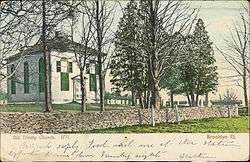Trinity Church (Brooklyn, Connecticut)
Trinity Church is an historic church on Church Street in Brooklyn, Connecticut. Completed in 1771 and little altered since, it is the oldest Episcopal church in the state.[2] Its congregation now meets mainly in a newer church at 7 Providence Street in Brooklyn Center, but still uses this building for special events. The building was added to the National Register of Historic Places in October 1970.[1]
Old Trinity Church | |
 | |
  | |
| Location | Church St., Brooklyn, Connecticut |
|---|---|
| Coordinates | 41°48′0.5466″N 71°55′26.976″W |
| Area | 2 acres (0.81 ha) |
| Built | 1771 |
| Architect | Unknown |
| Architectural style | Georgian |
| NRHP reference No. | 70000703[1] |
| Added to NRHP | October 5, 1970 |
Description and history
Trinity Church is located about 3 miles (4.8 km) east of the center of Brooklyn, on the east side of Church Street near its junction with Brown Road. It is a 2-1/2 story wood frame structure, with hip roof and clapboarded exterior. The siding is largely original, held in place by hand-cut nails. Ground-floor windows are set in segmented-arch openings, while the second-story windows are taller, and set in round-arch openings. The main facade is three bays wide, with a round-arch opening framed by pilasters and a fully pedimented gable. The interior has its original box pews, whose doors are mounted on wrought iron hinges. It also has the original pulpit and reading desk.[3]

Much of the money and effort to build the church came from Anglican churchman Godfrey Malbone, as a response to efforts to build a Congregational meetinghouse. Under Malbone's supervision, Trinity Church was finished in April 1771, ahead of the Congregational church. It is the oldest surviving Anglican church building in Connecticut.[4] It is modeled on churches designed by Peter Harrison, and was built in part with the labor of slaves supplied by Malbone.[3]
References
| Wikimedia Commons has media related to Trinity Church (Brooklyn, Connecticut). |
- "National Register Information System". National Register of Historic Places. National Park Service. April 15, 2008.
- "Colonial Meetinghouses of New England". Retrieved 12 May 2014.
- "NRHP nomination for Trinity Church". National Park Service. Retrieved 2015-01-17.
- "Colonial Meetinghouses of New England". Retrieved 12 May 2014.